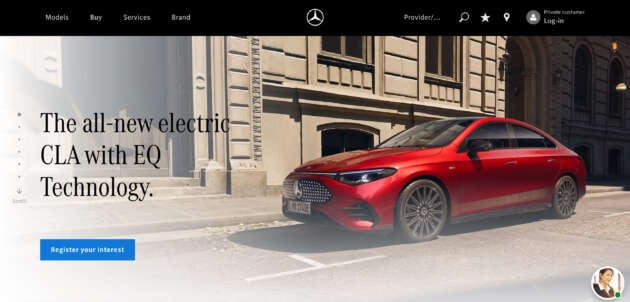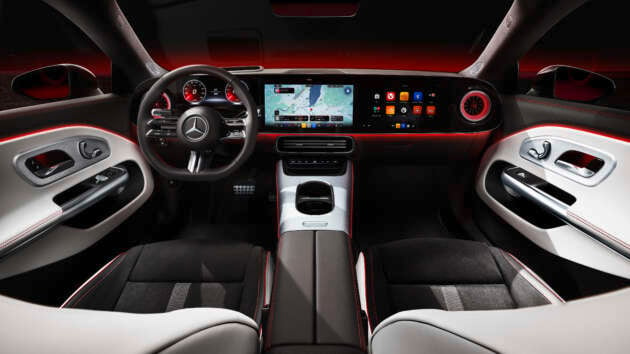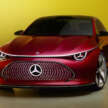
Eighteen months on from the unveiling of the Concept CLA Class, Mercedes-Benz has finally pulled the covers off the production C178 CLA. This third-generation four-door coupé marks a sea change for the nameplate as it enters its fully-electric era – at least to start with.
Let’s get the boring stuff out of the way first. The CLA rides on a brand new Mercedes-Benz Modular Architecture (MMA) for compact models, which will also spawn the CLA Shooting Brake and two SUVs (we assume these to be the next-generation GLA and GLB). You might notice that there’s no hatchback mentioned there, and that’s because the A-Class will be discontinued next year, with the consequence being that the CLA will soon be Stuttgart’s sole compact sedan offering.
As previously reported, the CLA was designed from the ground up to be an electric vehicle and thus features some startling technical specs. From launch, the car will be available in CLA250+ and CLA350 4Matic variants, both with the tedious “with EQ Technology” tag signifying electric propulsion.

Powering the CLA250+ is a single rear motor producing 272 PS (200 kW) and 335 Nm of torque, getting it from zero to 100 km/h in 6.7 seconds on its way to a top speed of 210 km/h. The CLA350 adds a 109 PS (80 kW) front motor to provide all-wheel drive and boost total outputs to 354 PS (260 kW) and 515 Nm – slashing the century sprint by nearly two seconds to 4.9 seconds.
More impressive is the efficiency, with Mercedes claiming that the CLA is the “one-litre car” (referring to the previous fuel consumption goal of 1.0 litre per 100 km for combustion cars) for the electric era. The company is touting measures such as getting the drag coefficient down to just 0.21, using of second-generation Electric Drive Units (EDU 2.0) with a Porsche Taycan-style rear two-speed transmission and adding the ability to quickly disconnect the front motor on the CLA350 to increase range.
All this enables the CLA250+ to deliver a claimed energy consumption of between 12.2 and 14.1 kWh per 100 km, and with an 85 kWh (nett) nickel manganese cobalt (NMC) battery as standard, this equates to an astonishing range of between 694 and 792 km on the WLTP cycle. The CLA350 is barely less efficient with energy consumption of between 12.5 and 14.7 kWh 100 km; as such, even it has a range of between 672 and 771 km. A 58 kWh lithium iron phosphate (LFP) battery option will be added by the end of the year.
Helping the CLA achieve such impressive range figures is a more powerful regenerative braking system that recuperates up to 200 kW, providing up to 3 m/s2 in deceleration. This enables it to cover almost every braking need; it will even do regen braking up to a complete stop. Users can select from three levels of regen braking (including off) or enable an adaptive mode using the steering wheel paddles.
The CLA is the first Mercedes EV to come with an 800-volt architecture, enabling DC fast charging speeds of up to 320 kW – just ten minutes of charging will provide up to 325 km of additional range. Unfortunately, as high tech as this car is, its AC charging power still only goes up to 11 kW, although the car will at least be able to send power back to the home through bidirectional charging, coming via software update later on.
While the CLA is designed to be electric-first, Mercedes is, like almost every carmaker out there, reevaluating its electrification strategy as global EV demand stalls. As such, it is hedging its bets by offering the car with a 48-volt hybrid powertrain. Not much has been revealed just yet, but the company has confirmed there will be three variants, each coming with a new 1.5 litre M252 Atkinson-cycle turbocharged four-cylinder engine and an electric motor housed within the eight-speed 8F-eDCT dual-clutch transmission.

Thanks to a 1.3 kWh battery, the hybrid will be able to drive purely electrically at low speeds when less than 27 PS (20 kW) is required; it will also be able to coast with the engine off at speeds of up to 100 km/h. The car will also be able to regen brake through all eight gears, recuperating up to 25 kW of energy.
In stark contrast to the powertrains, the CLA’s underpinnings are very conventional, with the front axle using a new three-link suspension setup – essentially a MacPherson strut with a lower wishbone. The multilink rear suspension, now standard-fit, has been derived from more expensive Mercs, as has a double bulkhead that improves refinement on hybrid variants. Passive comfort dampers come standard.
The design of the CLA follows the general direction set by the Concept CLA Class, retaining the trademark fluid shape and sweeping low-slung roofline. The latter has been stretched further rearward – presumably in the service of rear headroom, which has increased by 28 mm – leading to a six-window glasshouse (still frameless, obviously) and a slightly shorter rear deck.

At the front, you’ll now find full-width headlights, narrowing in the middle to frame the trapezoidal grille – this shape is mirrored in the taillights. The said grille is fully illuminated on the electric model, including the dinner-plate three-pointed star. Hybrid models are differentiated via an open grille with a single horizontal slat, plus a light band along the top edge.
Along the side, the CLA’s curved shoulder line has been broken up, now only appearing over the front and rear wheel arches to emphasise the car’s haunches. Wheel options range from 17 to 19 inches in diameter.
Mercedes’ rather narcissistic propensity to dot its three-pointed star all throughout the vehicle reaches new heights here. Instead of being limited to just the grille pattern (there are a total of 142 in there, in case you were wondering) or some interior trim pieces, this graphic has now been extended to the LED headlights – chrome as standard, illuminated on the optional Multibeam units. It even appears in the taillights, where it is joined by the characteristic ring and illuminated vertical bars spanning the full width of the rear.
Aerodynamic features include flush pop-out door handles, wing mirrors mounted on stalks on the door skins, and optimised wheel spoilers forward of the front and rear axles. Mercedes has also tweaked the positioning of the front shutlines and partially sealed them, while the underbody is now almost fully shrouded, including even the control arms and tie rods. The full two-tone wheel covers alone reduce the drag coefficient by up to two points, helping the CLA achieve the aforementioned 0.21 figure.
It doesn’t look it, but the CLA is quite a bit larger than the car it replaces. Measuring 4,723 mm long, 1,855 mm wide and 1,468 mm tall, the new model is 35 mm longer, 25 mm wider and 29 mm taller than the second-generation C118, while its 2,790 mm wheelbase is 61 mm longer. One casualty of electrification is the boot, which is now a whopping 55 litres smaller at just 405 litres. Helpfully, there’s finally a front boot for the first time on a Mercedes EV, and it’s pretty big too at 101 litres.
Inside, the CLA has a literal vertical wall for a dashboard, serving as the backdrop for the optional MBUX Superscreen. This houses the 10.25-inch digital instrument display and twin 14-inch touchscreens, including one for the passenger. Models without the Superscreen ditch the passenger display for the three-pointed star graphic, available with illumination.

This entire setup runs on a new MB.OS operating system, which jumps on the generative AI bandwagon by offering not one, but two models. The MBUX Virtual Assistant uses ChatGPT and Microsoft Bing searches for general enquiries, switching to Google’s Gemini for navigation-related questions. The system can retain context even when jumping between the two, so conversations can continue uninterrupted. The assistant is represented on screen by – you guessed it! – yet another three-pointed star.
The CLA gets the latest fourth-generation Mercedes-Benz User Experience (MBUX), utilising the Unity game engine for real-time 3D graphics. The “Zero Layer” interface first seen on the W223 S-Class continues here and now shows recently-used apps, while the app drawer now allows you to create folders, smartphone style.
Meanwhile, the navigation system uses Google Maps and will calculate the fastest, most convenient route based on factors such as road and traffic conditions, fast charger availability, temperature, speed, the car’s heating and cooling and even wind conditions taking into account the car’s height. This map is also overlaid on top of a Tesla-style “surround navigation” display that shows other motorists and pedestrians in 3D.

Beyond the tech, the CLA’s interior is exceedingly minimalist, an approach that has also informed the (lack of) physical controls. The still annoyingly touch-based steering wheel controls sees the two usual touchpads whittled down to just one for the instrument display (the touchscreen is now only controlled using, well, the touchscreen), enabling the remaining “buttons” to be made larger and hopefully much easier to use.
Unfortunately, Mercedes has followed the approach taken by Volkswagen and Volvo in removing the discrete rear window switches from the driver’s door. As with newer cars from those brands, the CLA requires users to press a “rear” button first before they can wind the back windows up or down. The seat memory buttons have also been removed – presumably these functions have been moved to the screen. Perhaps the company hasn’t learnt the lesson Volkswagen recently learnt…
Thankfully, Mercedes has at least seen fit to add some features, including proximity door locking and unlocking (finally) and a 16-speaker, 850-watt Burmester sound system with Dolby Atmos support. There’s also a new SoundExperience function that pipes in a synthesised “engine sound”, even allowing drivers to “rev” the car when stationary.

A CLS without the passenger display
Safety-wise, the CLA gains a new front centre airbag and a plethora of driver assists, including Distronic adaptive cruise control as standard in Europe. At launch, the car can be had with the optional Drive Assist package that adds lane centring assist for Level 2 semi-autonomous driving functionality, as well as lane change assist.
Later on, there will be a Drive Assist Plus that adds an improved Distronic Plus, with automatic lane changes also planned. The flagship system is Drive Assist Pro, which enables what Mercedes calls “Level 2++” semi-autonomy, hinting at hands-off (not eyes-off, which would be Level 3) driving. The system is planned for commercialisation in China this year and in the US in 2026.
-

-

-
Der neue Mercedes-Benz CLA mit EQ Technologie: Exterieur: AMG Line Plus, MANUFAKTUR patagonienrot metallic
The all-new Mercedes-Benz CLA with EQ Technology: exterior: AMG Line Plus, MANUFAKTUR patagonia red metallic
-

-

-

-
Der neue Mercedes-Benz CLA: Exterieur: AMG Line, clear blue metallic
The all-new Mercedes-Benz CLA: exterior: AMG Line, clear blue metallic
-

-
Der neue Mercedes-Benz CLA: Displayinhalt kann optisch vom Serienstand abweichen; AMG Line, Interieur: Schwarz/Clean White Pearl
The all-new Mercedes-Benz CLA: Display content may differ visually from the production model; AMG Line, interior: black/clean white pearlmetallic
-

-
Der neue Mercedes-Benz CLA: Exterieur: AMG Line, clear blue metallic
The all-new Mercedes-Benz CLA: exterior: AMG Line, clear blue metallic
-

-

-
Der neue Mercedes-Benz CLA mit EQ Technologie: Exterieur: AMG Line Plus, MANUFAKTUR patagonienrot metallic
The all-new Mercedes-Benz CLA with EQ Technology: exterior: AMG Line Plus, MANUFAKTUR patagonia red metallic
-

-
Der neue Mercedes-Benz CLA mit EQ Technologie: Displayinhalt kann optisch vom Serienstand abweichen; AMG Line Plus, Interieur: Schwarz/Clean White Pearl
The all-new Mercedes-Benz CLA with EQ Technology: Display content may differ visually from the production model; AMG Line Plus, interior: black/clean white pearl
-

-

-
Der neue Mercedes-Benz CLA mit EQ Technologie: Frunk mit 101l Kapazität
The all-new Mercedes-Benz CLA with EQ Technology: frunk with 101l capacity
-

-

-

-
Der neue Mercedes-Benz CLA mit EQ Technologie: Displayinhalt kann optisch vom Serienstand abweichen; AMG Line Plus, Interieur: Schwarz/Clean White Pearl
The all-new Mercedes-Benz CLA with EQ Technology: Display content may differ visually from the production model; AMG Line Plus, interior: black/clean white pearl
-

-

-
Der neue Mercedes-Benz CLA und der neue Mercedes-Benz CLA mit EQ Technologie
The all-new Mercedes-Benz CLA and the all-new Mercedes-Benz CLA with EQ Technology
-

-
Der neue Mercedes-Benz CLA mit EQ Technologie: Exterieur: Edition, AMG Line, kosmosschwarz magno
The all-new Mercedes-Benz CLA with EQ Technology: exterior: Edition, AMG Line, cosmos black magno
-

-
Der neue Mercedes-Benz CLA mit EQ Technologie: Displayinhalt kann optisch vom Serienstand abweichen; Edition, AMG Line, Interieur: Leder tartufobraun
The all-new Mercedes-Benz CLA with EQ Technology: Display content may differ visually from the production model; Edition, AMG Line, interior: leather tartufo brown
-

-
Der neue Mercedes-Benz CLA: Displayinhalt kann optisch vom Serienstand abweichen; Edition, AMG Line, Interieur: Leder tartufobraun
he all-new Mercedes-Benz CLA: Display content may differ visually from the production model; Edition, AMG Line, interior: leather tartufo brown
-

-
Der neue Mercedes-Benz CLA mit Hightech-Hybridmotor
The all-new Mercedes-Benz CLA with high-tech hybrid combustion engine
-

-
Der neue Mercedes-Benz CLA mit Hightech-Hybridmotor
The all-new Mercedes-Benz CLA with high-tech hybrid combustion engine
-

-
Der neue Mercedes-Benz CLA mit Hightech-Hybridmotor
The all-new Mercedes-Benz CLA with high-tech hybrid combustion engine
-





























































































































































































































































































































